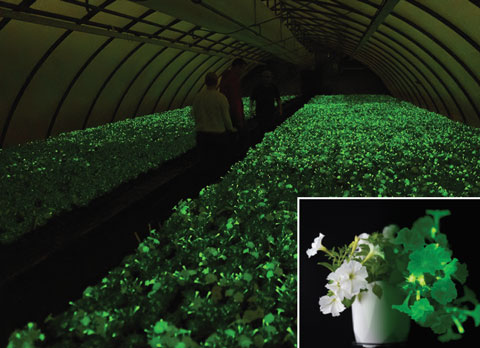7/1/2024
Bioluminescent Petunias: A Bright Spot in Horticulture
Susie Raker

Remember when the internet blew up in the ’90s? Businesses went from brick-and-mortar open Monday through Friday 8:00 a.m.-5:00 p.m. to a 24-hour-a-day-seven-day-a-week virtual worldwide business. The change was revolutionary and left many of us wondering what other major innovations were waiting in the wings to change our perception of “normal” in the future?
Forward to 2024 and the introduction of the bioluminescent petunia, Firefly—a revolution in gardening. This product is the ground floor of something new to our industry that can transform what our products mean to our customer base, change how our current customers use our products and introduce our products to a whole new base of customers. The ornamental horticulture industry, long reliant on traditional breeding methods, is witnessing a transformative shift with the advent of genetic engineering. This innovation isn’t just a novel curiosity, but a potential game-changer for breeders, growers and retailers looking to differentiate their product offerings and tap into new markets.
Historically, genetic engineering in ornamental plants has focused on enhancing traits such as flower color and disease resistance. While beneficial—especially to the commercial floriculture supply chain—these changes often appear as incremental improvements that our consumers may not even notice or don’t know exist in the products they’re purchasing. The real potential of genetic engineering lies in its ability to introduce entirely new traits that capture consumer imagination and open new markets.
Enter Firefly Petunia, a plant that glows in the dark. Developed by Light Bio, this petunia incorporates genes from bioluminescent mushrooms, allowing it to emit a continuous, soft glow from its flowers. This living light results from an integration of plant metabolism and mushroom bioluminescence, marking a significant breakthrough in synthetic biology.
In its inaugural year, the Firefly Petunia found remarkable success through online sales. The direct-to-consumer approach generated significant demand, prompting Light Bio to plan expanded production and distribution channels in its second year.
What sets the Firefly Petunia apart is its ability to attract a broad audience, many of whom aren’t traditional buyers of ornamental plants. Comments on social media indicate that the bioluminescence, rather than the fact that it’s a petunia, is the primary draw. This has effectively created a new market segment, and hopefully, some new gardeners. With new introductions in the pipeline, the goal will be to keep these new consumers engaged in the future.
Beyond its visual appeal, the Firefly Petunia creates a unique user experience. Bioluminescence promotes a real relationship with the plant—the healthier the plant, the brighter the glow—enhancing the overall experience for the consumer. Customers have described the bioluminescence as magical and soothing, noting how it transforms their living spaces and creates a sense of wonder.
As a gardener, I enjoy putting a plant in soil, taking care of it and watching it grow. But it’s been a long time since I’ve just sat and stared at a plant in wonder. This winter, I would find myself coming to the greenhouses at night just to sit in the Firefly Petunia greenhouses and stare with what I’m sure was a dumbfounded look on my face.
The success of the Firefly Petunia underscores the potential for bioluminescent plants to reshape consumer expectations and expand market reach. Light Bio plans to introduce even brighter and more diverse bioluminescent plants in the future. This ongoing development offers a path to sustained growth and consumer engagement.
The Firefly Petunia demonstrates how genetic engineering can move beyond traditional agricultural applications to create products that enhance consumer lifestyles in unexpected ways. The ability of these bioluminescent plants to create new markets, rather than merely compete within existing ones, highlights the transformative potential of synthetic biology.
This transformation isn’t limited to the Firefly Petunia. The biotechnology sector is increasingly exploring the development of ornamental plants with novel traits. From flowers that change color to those that emit fragrances on command, the possibilities are vast and varied. These innovations promise to keep the horticultural market vibrant and dynamic, continually offering consumers new reasons to engage with plants.
The horticultural industry’s embrace of genetically engineered plants like the Firefly Petunia is a testament to its commitment to innovation and consumer satisfaction. As these bioluminescent wonders become more widely available, they’ll inspire further advancements and applications in the field, driving the industry forward.
The Firefly Petunia represents a significant leap forward in the ornamental horticulture industry. You can now enjoy your garden at night, connecting with nature at all hours of the day. As Light Bio continues to innovate, the horticultural industry stands poised to benefit from these groundbreaking developments, leading the way into a bright and bioluminescent future. GT
Susie Raker is Vice President of Raker-Roberta’s in Litchfield, Michigan.